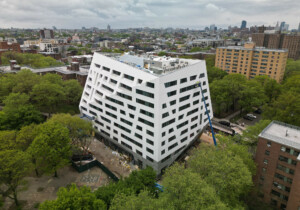An investigation by fire specialists BRE Global into the Grenfell Tower disaster was leaked exclusively to the Evening Standard, and their findings singled out the building’s recent renovation as a major cause of the fire’s disastrous impact. Compiled as a part of the police investigation into the June 2017 fire in London that killed 71, the 212-page report, dated January 31, 2018, claims that the poor quality of materials used and substandard installation practices during the 2014-2016 renovation turned the tower into a tragedy waiting to happen.
Built in 1974, the original Clifford Wearden and Associates-designed concrete tower block had been designed to passively contain potential fires. But the BRE report claims that the refurbishment failed to meet fire safety standards, and that cost-cutting led to serious mistakes throughout. It further states that, pre-renovation, the building’s original concrete facade would not have allowed the fire to spread beyond its fourth-floor starting point in Flat 16.
BRE identified several damning pieces of evidence of serious incompetence in the renovation. Besides the well-publicized use of a combustible polyethylene (combustible plastic) core in the aluminum-clad facade, the report also identified alleged incompetence by the contractors. Cavity barriers, which should have expanded when exposed to heat and sealed off the gap between the new cladding and original facade, were either too small, installed upside down or back-to-back. Instead of sealing the gap off, they instead created a “chimney effect” and funneled flames higher up the structure.
BRE also attributed the fire’s rapid spread to the installation of window frames that were approximately six inches shorter than the span of the concrete columns they had been installed between, and the use of a rubber membrane, foam insulation, and lightweight plastic panels to fill the gap. None of these materials would have provided over 30 minutes of fire resistance. Instead of restraining the fire, these materials allegedly fueled it, and allowed the fire to re-enter the building from the facade cavity.
Further compounding the issue is BRE’s finding that only 17 percent of apartments had automatic door closers that worked, which would have kept the fire from spreading to the building’s hallways and core. Other than the building’s total lack of sprinklers (a fact that caused an outcry in Britain when it was revealed), the BRE reports:
“A building of Grenfell’s height ought to have been fitted with a wet rising main [which contains water at all times] as part of the refurbishment; instead the existing dry rising main [which has to be supplied from a fire engine] was extended and modified.” Because the surrounding landscaping only allowed a single fire engine at the base of the tower, firefighters were unable to create an adequate amount of water pressure to reach the building’s upper floors.
While the investigation into the Grenfell fire is still ongoing, plans for the site’s remains have been moving full speed ahead. Once the forensic analysis of the building is complete at the end of this year, the tower will be razed and the site handed over to survivors of the fire, with plans to convert the site into a memorial.











